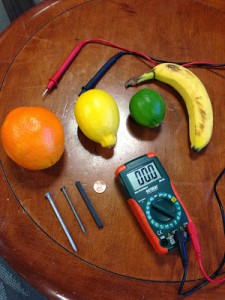 We utilize all sorts of batteries throughout our everyday lives. Cars, cellphones, and digital watches are all powered by some sort of battery. With that said, we were curious what kind of basic principles create a “battery.” A battery is a container that consists of one or more cells that produce an electro-chemical reaction when connected to a device. The experiment we chose was to create a battery out of a fruit (lemons, limes, oranges, bananas) using carbon as the constant element and switching out various conductive metals (zinc, copper, iron) as the second element. We hypothesized that the lemon would have the highest pH level and thus would generate the highest amount of voltage. Conversely, we had guessed that a banana would produce the least amount of voltage. For the experiment, we utilized a multi-meter to measure the voltage of each fruit and metal combination. Our results were fairly surprising. On average, copper was the least conductive metal – generating only .1 volts when implanted in a lemon. The galvanized (zinc-coated) nail produced the highest readings – producing .84 volts when implanted in an orange. The most surprising aspect of our findings was that the banana produced fairly high readings on the multi-meter. This is because the ascorbic acid found in a ripe banana tends to have a fairly higher pH level than the citric acids found in the other fruits.
We utilize all sorts of batteries throughout our everyday lives. Cars, cellphones, and digital watches are all powered by some sort of battery. With that said, we were curious what kind of basic principles create a “battery.” A battery is a container that consists of one or more cells that produce an electro-chemical reaction when connected to a device. The experiment we chose was to create a battery out of a fruit (lemons, limes, oranges, bananas) using carbon as the constant element and switching out various conductive metals (zinc, copper, iron) as the second element. We hypothesized that the lemon would have the highest pH level and thus would generate the highest amount of voltage. Conversely, we had guessed that a banana would produce the least amount of voltage. For the experiment, we utilized a multi-meter to measure the voltage of each fruit and metal combination. Our results were fairly surprising. On average, copper was the least conductive metal – generating only .1 volts when implanted in a lemon. The galvanized (zinc-coated) nail produced the highest readings – producing .84 volts when implanted in an orange. The most surprising aspect of our findings was that the banana produced fairly high readings on the multi-meter. This is because the ascorbic acid found in a ripe banana tends to have a fairly higher pH level than the citric acids found in the other fruits.

Brian Brewster, Kim Wallace, Joe Cesaro, Joe Scolley
